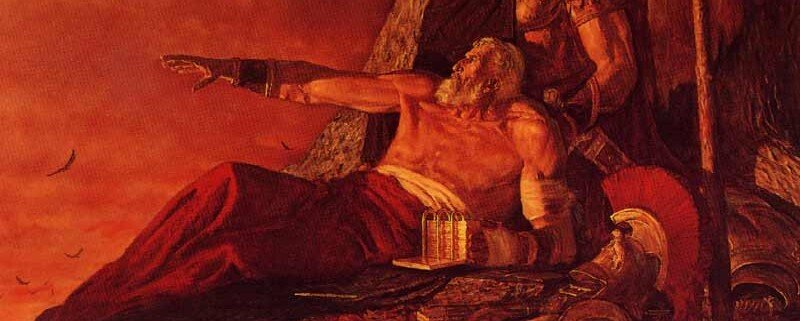Were the Book of Mormon Nephites actually Toltecs & Anasazi? Evidence for the Final Exodus and Battles
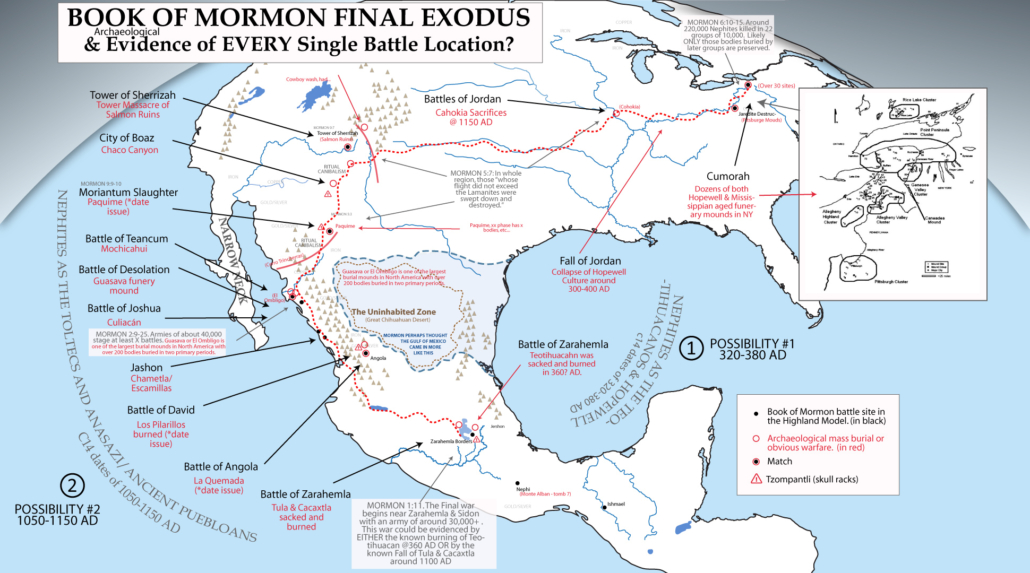
THIS ARTICLE IS UNFINISHED AND UNDER HEAVEY CONSTRUCTION.
Why do some Aztec chroniclers put the Aztec Migration from Aztlan at 439 AD and others put it seven hundred years later at 1168 AD? Could a difference in Calendars be causing us to overlook the overwhelming evidence for the Nephite destruction in the Book of Mormon?
.
Overview
It’s really kind of crazy comparing the Aztec migration histories, with the archaeology concerning warfare and social collapse in the twelfth century and the final genocide story of the Book of Mormon.
In the Continental Model I give two possible timelines for the final exodus and battles of the Nephite destruction. One with archaeological dates matching the Book of Mormon narrative’s dates of a Nephite destruction between 321-384 AD and a second radiocarbon dating to 1100-1150 AD. The traditional timeline has limited archaeological support but follows the Book of Mormon’s dates, matching the initial burning of Teotihuacan around 350 AD (Manzanilla, 2006) and subsequent fall of the Hopewell culture between 300-400 AD with the Book of Mormon Events of Mormon chapters 2-9. A second timeline however, matches overwhelming archaeological evidence of mass warfare, migration and social collapse stretching from Tula in the Valley of Mexico along the narrow West Mexican corridor to the American southwest Puebloans/Anasazi cultures, and onto Cahokia and New York between 1100-1150 AD. Although the twelfth century collapse of the Toltec, Anasazi postdates the timeline given in the Book of Mormon by 700 years, the remarkable similarities between the archeological evidence and the Book of Mormon narrative’s events make it hard not to believe that these were one and the same events.
In this paper we explore numerous pieces of evidence pointing to why the Book of Mormon dates and archaeological dates might be off by 700 years. The most impressive of which is historical evidence of confusion caused by a different base-date for the Chichimec calendar of northern Mexico people than the Toltecs of central Mexico. This same confusion would actually cause Fernando Ixtlilxochitl’s to place events similar to the Book of Mormon such as the destruction of the Toltecs around 300-400 AD, when archaeology shows it seems to have actually occurred around 1050-1150 AD.
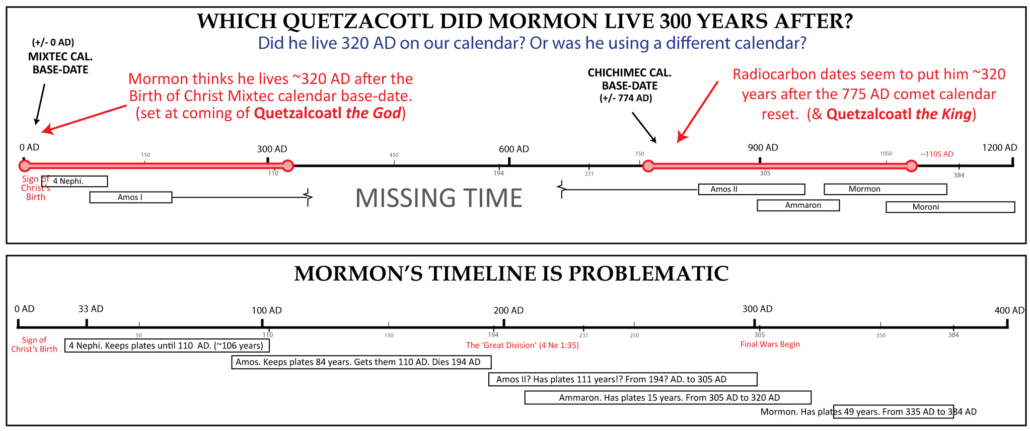
.
Could Mormon have been a Toltec?
Its hard not to acknowledge the overwhelming similarities between the historical and archeological demise of the Toltec and the destruction of the Nephites in the Book of Mormon narrative.
The Spanish/native historian Ixtlilxochitl wrote one of the most complete accounts of the demise of the Toltecs in his well known book, Obras Historicas. It it we read a story unbelievably similar to what’s related in the Book of Mormon concerning the fall and destruction of the Nephite nation. He even begins his account by telling of an “astrologer” or prophet who lived around 400 AD and compiled the Toltec scriptures!
2:4. And before going on, I want to make an account of Huematzin the astrologer [prophet]….
2:5. Before dying, he gathered together all the histories the Tultecas had, from the creation of the world up to that time and had them pictured in a very large book, where were pictured all of their persecutions and hardships, prosperities and good happenings, kings and lords, laws and good government of their ancestors, old sayings and good examples, temples, idols, sacrifices, rites and ceremonies that they had, astrology, philosophy, architecture, and the other arts, good as well as bad, and a resume of all things of science, knowledge, prosperous and adverse battles, and many other things; and he entitled this book calling it Teoamoxtli, which, well interpreted, means Various Things of God and Divine Book.
2:6. The natives now call the Holy Scriptures Teoamoxtli, because it is almost the same, principally in the persecutions and hardships of men
However, other authors place the same Aztec exodus around 1168 AD, and even elsewhere in Ixlilxochitl’s history, he changes his date to the twelfth century.. Other authors like Torqmada and — (reference them) use the later date… which got me thinking…
-then I read Gordon Brotherston who explained that that most of the codices from central and southern Mexico had a “base date” from which the many calendar dates within them were calculated. (A Key to the Mesoamerican Reckoning of Time) proposing the idea that Ixlilxochitl and other authors might have been confusing different base dates.
The Tulteca & Mayan base date is the year 13 Reed 3114 BC; the Mixtec from Tilantongo, Oaxaca, 13 Reed 11 AD as shown in the Codex Boturini [strangely similar to the Christian and Book of Mormon base date]; and the Chichimec, 13 Reed 647 AD [strangely similar to the 774 carbon spike and Quetzalcoatl the prophet date]. The Codex Vienna has the Tulteca base date, 3114 BC (Codex Nuttall, pp. 73, 76), although in the Mixtec art style, while the Codex Nuttal has the Mixtec base date, AD 11 (Codex Nuttall, p. 4). reference here adapted from Bruce W. Warren.
This idea of different base dates combined caused me to suddenly rethink all the archaeological evidence for cultural collapses and battles, which I had consistently noticed were amazingly similar to the Book of Mormon narrative but that I had before either dismissed or wondered if there was a possible error in the radiocarbon dates for the 11-13th centuries.
Events like those in chart & list below show overwhelming similarity to the Book of Mormon. And having researched the 774 carbon spike previously with its likely indication of a massive Solar Flare or comet event, I decided to do the math and see how the dates would line up if I adjusted them to a ‘Chichimec’ calendar that used the signs & wonders of the 774 Carbon Spike event, instead of the 34 AD Time of Christ signs mentioned in the Book of Mormon. Amazingly, the dates match up nearly to the decade! It simply seemed too good a match to not be true. By supposing that Mormon did not realize there was a huge ‘lacuna‘ (or gap) in the records he was using (which is expected since the Toltec dating systems stopped at 540, and then reset), and that there was actually a missing ~740 years between the signs and destructions of Christ and the signs & destructions of the 774 comet event which Mormon as a Chichimec used, then essentially EVERY DETAIL of the final flight, collapse war and destruction of the last part of the Book of Mormon lines up with archaeological findings.
.
Evidence of the Book of Mormon final retreat and battles in the archaeological record
.
| Book of Mormon Event | BOM Date | Adj. Date | Archeological Event | c14 date |
| Double fulfilled sign of Christ’s Birth | 0 AD | 0/774 AD | 774/5 AD X-Solar Flare & C14 Spike (begin Mixtec Calendar) | 774 AD |
| The ‘Great division’ occurs (4 Nephi 1:35) | 231 AD | 1005 AD | One age (520yrs) before Aztec destruction (in 1517). | 1010 AD |
| War near Zarahemla (Mormon 1:10) | 321 AD | 1095 AD | Tula decline (8-Deer seizes throne of Tilantongo) | 1100 AD |
| Gather to Joshua (Mormon 2:7) | 330 AD | 1104 AD | La Quemada/Los Pilarios? (Chichimec migration) | — |
| Treaty of Narrow Pass (Mormon 3:5–8) | 350 AD | 1124 AD | Guesave Mound | 1100 AD |
| Tower of Sherrizah | 370 AD? | 1144 AD | Salmon Ruins Massacre | 1130 AD |
| Moriantum girls sacrificed (Mormon 9:9) | 370 AD? | 1144 AD | Cahokia Teen Female Sacrifices | 1100 AD |
| Total destruction at Zarahemla? | — | — | Tula burned & abandoned. (by Chichimec Xólotl) | 1140 AD |
| Flight from Boaz (Mormon 4:20–22) | 375 AD | 1149 AD | Chaco Burned & Abandoned | 1150 AD |
| Final stronghold (Jordan) defeated (Mormon 5:4) | 380 AD | 1153 AD | Aztlan Mounds fortifications, canibalism, bodies | 1150 AD |
| Final stronghold (Jordan) defeated (Mormon 5:4) | 381 AD | 1153 AD | Toltec Mounds abandonment | 1100 + |
| Final stronghold (Jordan) defeated (Mormon 5:4) | 383 AD? | 1155 AD | Cahokia Final Burning & Abandonment | 1170 AD |
| Final Battle (Mormon 5:5–7) | 384 AD | 1158 AD | Cumorah Mounds | 1200 AD |
| Nephite Survivors “head south” | 385-400 AD | 1159 AD | Southeast Ceremonial centers | 1200 AD |
| Lamanite survivors arrive back in Zarahemla? | ~400 AD | 1174 AD | Acolhua entered the Valley of Mexico w/Huetzin | 1168 AD. |
1150–1200 CE is also when the french word adieu (Jacob 7:27) begins to appear in french literature such as works like the Chanson de Roland (c. 1140–1170).
.
Table Event Details
774 AD Radiocarbon/Solar Event. Tree rings for this date show an increase of around 1.2% in the concentration of the radioactive carbon-14 isotope in tree rings dated to 774 or 775 CE, which is about 20 times higher than the normal year-to-year variation of radiocarbon in the atmosphere. Likely caused by a X-Class Solar Flare or possibly a major comet impact combined with some type of solar event. Evidence shows that certain Chichimec, and perhaps Mixtec calendars were restarted at this date. If this event indeed impacted the Western Hemephere and was recorded by Native American authors and reset their calendars, Mormon may have confused this with other records in his library speaking of the similar Birth of Christ event which also reset their calendars based on impressive signs in the heavens. (great reference on 774 event)
Fall/Destruction of Tula, (skull rack). Tula [Toltecs] fell about 1150 AD, but began its decline some time earlier. The Mixtec/Zapotec civil war of 1090 AD from the xxx codex, where 8-Deer seizes the throne of Tilantongo may be the best evidence. With Tula’s end, the Post-Classic pattern came into focus in vibrant clarity: expansive politics, long-distance dynamics, power plays and upheavals, and a swirling world of migrations, invasions, expulsions, and fragmentation. —Lekson p. 242 Figure 9 in “Revised chronology and settlement history of tula and the tula region”, (Healan, et al, 2021), shows the date for the burning and abandonment of various Tula structures. There is evidence of civil unrest as early as 987, but abandonment happens closer to 1065-1180 AD range. Mixtec histories tell that in 987 AD, A rival, Tezcatlipoca, forced Quetzalcoatl out of Tollan, and although legend has it that the latter sailed east across the Atlantic, it is more likely that he invaded Yucatan as the Toltec invader of that time was also called “Plumed Serpent” (Kukulcan in Mayan) (Pohl, 1991; DBR). Then in 1090 8-Deer seizes the throne of Tilantongo after the old lord dies without an heir (Pohl, 1991). Jaltepec realigns itself with a Zapotec competitor to eliminate Tilantongo from the Mixtec alliance structure. (reference here)
Healan 2021 offers precise radiocarbon dating sequences with last firing of main Kiln yielding 1140-1190 AD, Burned stucco from Palacio Quemado, Tula Grande’s destruction by fire at 1140 AD, with five other burn dates of 1175 AD.
La Quemada Destruction, (get the early report, mention the newer later dates), Over 25 skulls, and many disarticulated skeletal parts. Early c14 dates returned 3 of 10 dates in the 500-740 AD range (13 samples). See “The Dating of La Quemada and Theory of its Development”, Christopher Salinas, UWLC Thesis. (I have in pdf repo.) Even though the radiocarbon dates for La Quemada Los Pilarillos is off, I get the feeling that these sites are related to the Chichimeca, and that these battles match the 1111 AD date of the Mixteca leaving Aztlan. (traveled through Chichimec territory to Chicomoztoc – ref)
Los Pilarillos Destruction. huge kill site. “large number” of females, males and babies dead. Grisly pics of mass grave & “Trophy Skull & Femur”. (I highly disagree with archaeologist in thinking its not war because of age and location. skull rack?) Dates match La Quemada. See “Burial Excavations in Plaza 1 of Los Pilarios, Zacatecas, Mexico. Ben A Nelson, 1997. (I have). I think its likely that Los Pilarillos & La Quemada’s radiocarbon date determinations have been corrupted by emitions and/or ash falls from the Colima or Ceboruco volcanic complex. The Ceboruco volcano is known to have erupted in 930 +-200 years (so possibly 1130 AD), and the Colima volcano is known to have erupted three times dated to 1110 AD +-200. If wind directions were to the northeast, these sites could have been covered in non-radiogenic CO2 & ash, skewing the dates older than their reality. (I actually had a dream suggesting this to me)
Funerary (Battle?) Mounds of Guesave/El Ombligo contain remains of 196 individuals (p.219). Most date between 1020-1220 AD (p.231) (talk about how battle graveyards become local graveyards.) Pottery sequences place between 1100-1350 AD. Nearby Huatambampo dates earlier at perhaps 900-1100 AD. A handful of trophy skulls could suggest that at least one layer of the burial mound was battle related, although a lack of trauma marks on bones would suggest only spears were used as death instruments. See “El ombligo en la labor: Differentiation, interaction and integration in prehispanic Sinaloa, Mexico” John Philip, 1957.
–Mochicahui, not bodies, but proof there were cities. Radiocarbon dates are scarce but one mentioned on page 184 is between 830 AD uncalibrated and 1225 calibrated.
Trincheras Hilltop Fire Signal System. Dates mostly between A.D. 800 – A.D. 1450.
—Paquime. Lots of dead bodies but site undoubtedly continued to be used after 1050 AD. The main burning and abandonment likely dates to ~1400 AD. Find if there was perhaps an earlier episode of burning.
Chacoan Explotion & Collapse. (Skull Racks, Cannibalism) Most pit house communities were constructed and occupied in the highlands surrounding Chaco Canyon around 1100 AD, most probably with farmers dispersed from the Red Mesa Valley and other areas sound of Chaco; most of these [if not all] were attacked and burned around 1190 AD (Stuart). Kin ya’a and many other prominent Chaco Great houses were burned and abandoned around 1150 AD.
Salmon Ruins Massacre. Founded just before 1100, Salmon was a Chacoan refuge until a number of its women and children were burned in the tower kiva that once arose from the main block. —Anasazi America, by David E. Stuart, p. 105. It was apparently attacked and more than 30 women and children who had sought refuge in its impressive tower kiva died horribly in a fire set to destroy the town in about 1130 AD. —Anasazi America, by David E. Stuart, p. 136.
–Other sites with massacres?
Cahokia Population Explotion & Collapse. Population explodes around 1050 AD. Large pit (Mound 72) contained more than 270 bodies – the majority of them young women killed as victims of human sacrifice. Post from pit shows it was dug as early as 950 AD Six periods of internment are contained. With a local elite level dating to 1030 AD. Many dates exist for main teenage girl sacrifice, late dates span to 1100 AD. (see Kathryn Koziol, 2010 ‘A case study of mound 72’ for detailed dates & description) Fire rips through at 1170 AD, and its population precipitously declines by 1200 AD. See “Epic Fire Marked ‘Beginning of the End’ for Ancient Culture of Cahokia“, Blake Pastino. Or Munoz et al. Another states, At Cahokia’s Mound 72, there are hints of a dark side within the uniting religion. Nineteen women are buried in a mass grave, dating to roughly the beginning of the city. Were they sacrificed? War captives? Rebels? We may never know. Around 1150 CE, civil war broke out. A huge palisade wall, made from more than 20,000 thick tree trunks, was built around one neighborhood. Two other neighborhoods were burned. “By 1180, people were beginning to leave,” says Dye. “By 1250, half of the people are gone” (Chris McCoy, 2024)
Aztlan Mounds were also rapidly built up around 1000 AD, fortified around 1140 AD and abandoned around 1220 AD. Late faze sees traumatic/violent deaths for 80-90 unburied individuals with evidence of burned, butchered and cannibilized remains. (Aztalan Site History, Milwaukee Public Museum) Abandoned by 1220 (“Chronology for Mississippian and Oneota Occupations at Aztalan and the Lake Koshkonong Locality”, Krus & Jeske, also available here)
Toltec Mounds (Plum Bayou) was abandoned ‘abruptly about 1100 AD. (Drake, 2001 Thesis. Rolingson, 1999) A more recent and perhaps more thorough paper without radiocarbon dates puts the date at 1050 AD in five separate instances. “The date for the beginning of Cahokia’s flourishing, perhaps not coincidentally, is approximately A.D. 1050, the same as Toltec’s abandonment… but Toltec certainly was not abandoned in a day”. But notes top layer was plowed off. (Alspaugh 2014 – Examining Late Occupation on Mound D at Toltec Mounds)
New York Burial Mounds. New York burial mounds lay in a bimodal series, with many being from the Hopewell period of 100-400 AD, and most others laying predominantly in the Mississippian cultural tradition of 1000-1200 AD. The Hopewell era burial mounds can be read about in “THE CANEADEA MOUND: A LOOK AT THE MIDDLE WOODLAND PERIOD IN THE NORTHEAST” by Steven Howard 2005. The later dates can be found here.
–Southeast Ceremonial Centers like Etowah see a dramatic build up at about 1000-1200 AD see Reinventing Mississippian Tradition at Etowah Georgia.
.
Outline of Toltec History (from Colonial Native Sources)
900 AD
Alta Vista (Zacatecas) control of Turquoise road replaced by control from Quemada (Zacatecas). Copan abandoned. Last recorded Long Count (at Itzimtè). Petén depopulated. Xochicalco burned and abandoned.
987 AD
A rival, Tezcatlipoca, forced Quetzalcoatl (= Ce Àcatl Topìltzin) out of Tollan, and although legend has it that the latter sailed east across the Atlantic, it is more likely that “Tlapàllan was the Yucatan which he took over as the Toltec invader of that time was also called “Plumed Serpent” (Kukulcan in Mayan) (Pohl, 1991; DBR).
1068-1076 AD
Codex Ramirez has Migration beginning in Chicomoztoc (seven caves); They laid the place waste when leaving; Tlacuxquin, Mança-moyagual and Mina-queciguatle were born
1090-1115 AD
8-Deer seizes the throne of Tilantongo after the old lord dies without an heir (Pohl, 1991). Jaltepec realigns itself with a Zapotec competitor to eliminate Tilantongo from the Mixtec alliance structure. Norman conquest is 1066 AD, perhaps they make it to America around 1100 AD? Codex Vatiacanus has this as date of leaving Chicomoztoc.
1111 AD
Approximate date the Mexica left Aztlan, their traditional homeland, traveled through Chichimec territory to Chicomoztoc (‘Seven Caves’; the nomad mustering location), and Cuhuacan (‘Curved Mountain’) (Davis, 1973). Chicomoztoc and Cuhuacan are legendary places and the second should not to be confused with the Cuhuacan in the Valley of Mexico.
1163 AD
Having settled in Coatepec (‘Hill of the Serpent’) near Tollan, the Mexica celebrate the first New Fire of their journey (Davis, 1973)
1156 or 1168 AD
Tula destroyed. Following internal dissention and pressure from migrating Chichimec, the Toltec fled their capital Tollan (Davis, 1973; the date is disputed and could be 1156; Pohl, 1991, says 1178). The last Toltec ruler hanged himself at Chapultepec, a future resting place of the wandering Mexica. The new waves of Chichimec under their warlord Xólotl (‘Monster’) took over the Valley. Tenyuca became the capital of a Toltec-Chichimec empire formed from Toltec remnants and Xólotl’s people (Davis, 1973). Old Toltecs flee into diaspora.
In 1168 AD the Mexica left Coatepec after an abortive rising of against their priest rulers (Davis, 1973). They briefly visited the desolate Tollan, and moved on to Xaltocan in the Valley of Mexico, and Tenyuca (‘The place where the walls are made’) to the west of Lake Texcoco. At that time Xaltocan was the capital of an empire stretching out to the north-east. Several times during this journey the Mexica encountered Huaxtecs, who at that time probably extended further west than their later home on the Gulf of Mexico, including, presumably at a place called Cuextecatl-Ichocayan (‘the place where the Huaxtec wept’).
Toltec lords established other distant capitals at Coixtlahuaca in Oaxaca.
(See Thomas 2003, Timeline for Mesoamerica or Ten Chronologies of Ancient Mexico, Zoltan Simon. or
.
.
Outline of Book of Mormon Final Exodus & Destruction
The final exodus and destruction of the Nephite people took 57-63 years to cover an unknown distance between at least 12 different lands and/or towns from start to finish. Compare that to the exodus of the early Mormon pioneers who coved 2160 miles over a 17 year period building at least as many cities in the 3 major regional centers of Ohio, Illinois/Missouri and Utah, and its easy to see why limited Book of Mormon geographic models which suggest the Nephites only fled 200-300 miles to avoid complete genocide are hard to believe when compared to historical analogs. Whether it be the 900+ mile trail of tears, the 1100+ mile Ostrogothic migrations, 1900+ mile Visigoth migrations, 3000+ mile Turkic migrations or the 2200+ mile Oregon trail, history shows that incredibly large numbers of people are entirely willing and able to cover enormous distances in hopes for a better life.
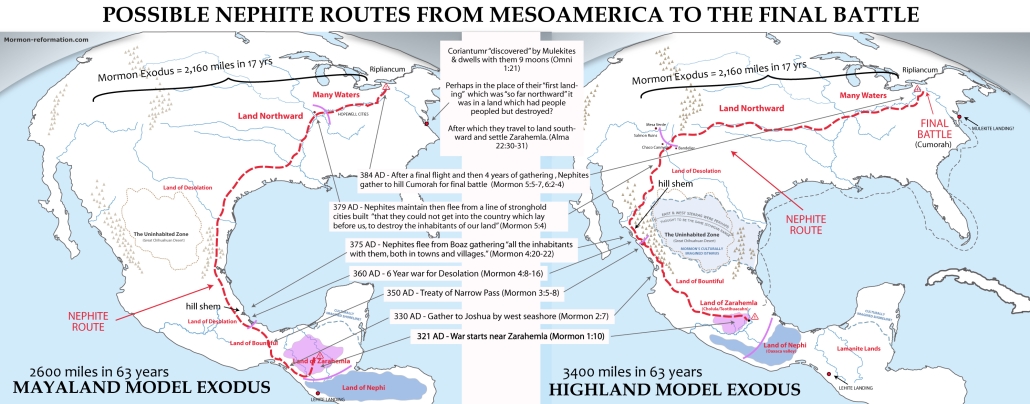
Summary of cities:
Land of Cumorah
City of Jordan (north-most city. part of line of cities defending north country)
—-
City of Boaz (gets rest of records from hill Shim; so still near Antum)
Teancum (by seashore & “near the city of desolation”)
City of Desolation in land Desolation (dead cast into sea)
Narrow Pass or Passage (presumably southward of desolation – treaty boundary)
City of Shem in land of Shem (people gathered & city fortified – could be north of Desolation)
City of Jashon in land of Jashon (near Land Antum so gets records – could be north of Desolation)
Land of Joshua (west by seashore)
—
Land of David (still no mention of any sea)
City of Angola (fortified city, first retreat after Zarahemla.)
Land Zarahemla (war starts)
.
Mormon apparently raised in Antum (where Ammaron & the Hill Shim & records are), near the land of Desolation and Jashon, Shem, Teancum & Boaz.
– 321 AD Moroni gets instructions to go to hill Shim in the Land Antum to get records at age 10 (Mormon 1:3)
-Moroni “carried by his father into the land southward, even to the land of Zarahemla” at age 11. (Mormon 1:7)
-War begins “in the borders of Zarahemla, by the waters of Sidon”. (first battle, also 321 AD) Mormon 1:10
-A number of battles fought, then a truce for four to six years.
-326 AD. At 16 Mormon put in charge of armies.
-327 AD. Lamanites attack again, Nephites retreat “toward the north counties” (Mormon 2:3)
-Moroni’s army take and fortify city of Angola “with their might”, but “notwithstanding their fortifications”, the city is taken. (Mormon 2:4)
-They are “also” driven out of the land of David. (sounds like Angola was not in land David likely next province to the north) Mormon 2:5
-330 AD. They march forth and gather in “one body” to land of Joshua which is “west by the seashore”. (Mormon 2:6–8) A battle with a force of 40,000 each is fought here… Lamanites retreat. Because of robbers land is “one complete revolution.”
-345AD. Lamanites attack again, Nephites retreat & are pursued to city of Jashon in the Land of Jashon, “near the land [Antum] where Ammaron had deposited the records”. Moroni gets just the plates of Nephi, and leaves the remainder “where they are.” (Mormon 2:17)
-346 AD. Nephites driven “northward to the land which was called Shem”. (Mormon 2:20) Nephites fortify the city of Shem and are attacked in 346 AD, but win a battle with 30k to 50k. (Mormon 2:25)
-In 350 AD a treaty is made with Lamanites AND the robbers of Gadianton. They “give unto us the land northward, yea, even to the narrow passage which led into the land southward. And we did give unto the Lamanites all the land southward.” (Mormon 2:29)
-For 10 years (350-360 AD), Nephites fortify and prepare. In 360AD Mormon causes his “people that they should gather themselves together at the land Desolation, to a city which was in the borders, by the narrow pass which led into the land southward. 6 And there we did place our armies, that we might stop the armies of the Lamanites, that they might not get possession of any of our lands; therefore we did fortify against them with all our force. 7 And it came to pass that in the three hundred and sixty and first year the Lamanites did come down to the city of Desolation to battle against us”. Nephites beat them. They come again the next year. They beat them a third time. “and their dead were cast into the sea.” (Mormon 3:5–8)
Desolation is by the sea (since dead are thrown in the sea there), by the ‘Narrow Pass’
-in 363AD, the Nephites go on the offensive, up out of desolation, but are driven back to “the land of Desolation” (not city). Then Lamanites attack, and take the city of desolation “slaying many and taking many prisoners”. (Mormon 4:2
-”And the remainder did flee and join the inhabitants of the city Teancum. Now the city Teancum lay in the borders by the seashore; and it was also near the city Desolation.”
Teancum is also somewhat near the sea.
-364AD, Lamanites come against Teancum, and are repulsed, so Nephites follow them and retake Desolation. (Mormon 4:8)
Desolation and Teancum are quite close to each other (With absolutely NO indication that they are on opposite sides of the Narrow Neck. — All this seems to occur on the West Sea)
-In 366AD Lamanites attack and take Desolation, and then Teancum (and sacrifice the inhabitants both women and children.) Nephites are so angry about the loss of their families they retake the cities and drive the Lamanites out of the land. Then another 10 year pause in fighting (Mormon 4:16)
-In 375AD, the Lamanites come down to desolation with a numberless host. The Lamanite attack base is UP from desolation and Teancum. (Mormon 3:7, 4:17-19) Lamanites come down to desolation. V.1-4 Nephites go up out of desolation to battle Nephites. This makes a northern neck or Cerro trinchera location problematic for desolation and the narrow neck. Perhaps likewise for Mazatlan…Nayarit and Amapa seem more likely.)
-Nephites flea to City of Boaz and fight two battles (still 375 AD? 54 Years after beginning of war). On second attack they flea and women and children are sacrificed again. Nephites flea and “all the inhabitants with them, both in towns and villages” (Mormon 4:22)
-“Seeing the Lamanites were about to overthrow the land”, Mormon goes to the hill Shim and takes up ALL the records. (Mormon 4:23)
Hill Shim is also mentioned in conjunction with the early Jaredites
-“Omer departed out of the land with his family, and traveled many days, and came over and passed by the hill of Shim, and came over by the place where the Nephites were destroyed, and from thence eastward…” (Ether 9:3)
City of Boaz is still relatively close to all the preceding cities? (Antum, Jashon, Desolation). V.10-23 really gives that impression. It’s like they don’t go far from Desolation to Boaz… but once Boaz is taken they “overthrow the land” (Mormon 4:23), so that he has to “take up all the records”. So everyone seems to flee far away to Jordan. (Jordan could now be the southwest (or Cohokia?), since “their towns, and villages, and cities were burned with fire” (Mormon 5:5).
-in 379AD Nephites flee to city of Jordan, and repulse a Lamanite attack. (Mormon 5:3) They maintain a line of stronghold cities “that they could not get into the country which lay before us, to destroy the inhabitants of our land.” (Mormon 5:4)
Jordan is likely in the Southwest, one of a line of cities defending the land northward.
-in 380 AD. Nephites begin final flight from Jordan (southwest) to Cumorah. (Mormon 5:6) Anyone whose flight isn’t faster than the Lamanites is swept down. 59 Years from the beginning of the war.
-in 384 AD Mormon sends a letter to Lamanites requesting to gather to the land of Cumorah “in a land of many waters, rivers, and fountains;” People finish gathering to Cumorah in 384 AD for final battle. 63 Years after beginning of war. (Mormon 6:2,5–6)
-401 to 421 Moroni finishes writing the rest of the book and hides it up. 17-38 years after the final battle.
— The Tower of Sherizah (Moroni 9:7–8), and the rapine of Moriantum (Moroni 9:9–10), as well as the accompanying “sore battle” where Archeantus, Luram and Emron fall”; give no indication of location except that they likely occured after the sacrifical depravity in the battle for Teancum & Boaz in Mormon 4:14–15,20–21.
Some thoughts on dates in the final retreat and battle:
Note that the Jewish Metonic cycle adds seven intercalary years (leap year) every 19 years. So one roughly every 2.7 years. In strangely similar to the prodigious use of 18,19 & 20 in the Mayan Calendar. I suspect the Baha’i calendar may be closer to the way the ancient Mesoamerican and ancient Israelites did it, than the current calendar’s.
If this is true… It may be that the Nephites after Christ’s time counted a “prophetic year” (or one of their calendars) as roughly every 2.7 – 3 true sidereal years. Which is a possible explanation for the discrepancy between Carbon dates for cultural collapses and BOM dates. So 321 AD would be coincide with 963ish AD and 380 AD would coincide with 1140ish AD. Making both Anasazi and Cahokia dates work. Probably more likely though, that either C14 dates are skewed or the records the authors were working off of, were wrong or misunderstood.
https://en.wikipedia.org/wiki/Metonic_cycle
https://en.wikipedia.org/wiki/Bah%C3%A1%27%C3%AD_calendar
https://en.wikipedia.org/wiki/Maya_calendar#Haab’
.
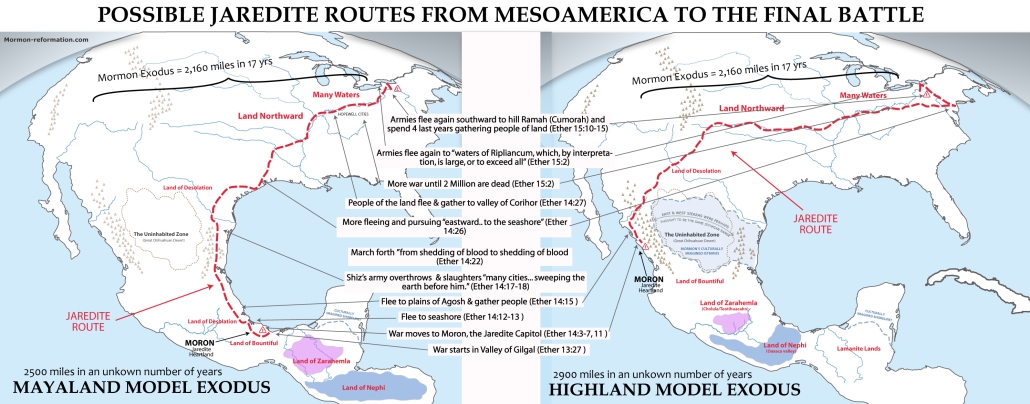
Outline of Jaredite Geography (In relation to their exodus to Cumorah)
– Jaredite barges land in an unknown location after 344 days on the water (Ether 6:11). Floating ducks might give some insight to how far things float in a year, and give evidence for a pacific vs. Atlantic journey.
– Corihor leaves Jaredite ‘Land of inheritance’ and “goes over and dwelt in the land of Nehor” (Ether 7:4).
– Corihor comes back to the Jaredite ‘Land of inheritance’, called Moron and takes the king captive (Ether 7:5).
– Jaredite ‘Land of inheritance’, or ‘land of Moron’, was near the land which is called Desolation by the Nephites (Ether 7:6).
– Shule “came to the hill Ephraim” and “made swords out of steel” and battles Corihor in the “city of Nehor” (Ether 7:9)
– Country or land of inheritance “was divided; and there were two kingdoms, the kingdom of Shule, and the kingdom of Cohor” (Ether 7:20)
– After 2 generations Jared rebelled “and came and dwelt in the land of Heth.” (Ether 8:2) Where he flatters away half his fathers kingdom (presumably moron) so we’re still close to land of inheritance.
– Ether 8:21 shows that the Nephites are already destroyed when the Book of Ether was written.
– Omer is warned in a dream and so “departed out of the land with his family, and traveled many days, and came over and passed by the hill of Shim, and came over by the place where the Nephites were destroyed, and from thence eastward, and came to a place which was called Ablom” with all his family & royal household. (Ether 9:3)
– A small number of men “flee out of the land, and came over and dwelt with Omer” (Ether 9:9)
– Civil war results in the “destruction of nearly all the people of the kingdom, yea, even all, save it were thirty souls.” So Omer was “restored again to the land of his inheritance”, which we presume is Moron (Ether 9:12–13)
– After 62 years, Omer’s son Emer rebuilds a kingdom (with what people?) who become rich and have all sorts of cloths, metals and animals including; silks, gold, silver, cows, goats, horses, elephants, cureloms and cumoms. (Ether 9:14–19)
– Emer’s son Coriantum “builds many mighty cities”, lives to 142 and under his son “people spread again over all the face of the land” then there’s a dearth and their flocks began to flee [from Moron or Desolation] before the poisonous serpents, towards the land southward, which was called by the Nephites Zarahemla” (Ether 9:20–31)
– Note these references. Land of Desolation. Alma 22:30–32; Mormon 3:5; Ether 7:6.
– Ether 9:32 says, “many of [their flocks] did perish by the way; nevertheless, there were some which fled into the land southward.” Ether 9:34 says serpents “hedge up the way that the people could not pass,” and “the people did follow the course of the beasts.. and devoured them all” This suggest the Land Southward/Zarahemla is really far away from Moron/Desolation. Alma 22:30 sounds like that as well. Most people die, and Shez begins to “build up a broken people” (Ether 10:1)
– Shez “did build up many cities upon the face of the land, and the people began again to spread over all the face of the land.” Ether 10:4
– Morianton sounds like an outsider from a different land (although it doesn’t specify) who “gathered together an army of outcasts, and went forth and gave battle unto the people; and he gained power over many cities” until he “gain power over all the land, and did establish himself king over all the land” and then he “built up many cities” (Ether 10:9–12). He could easily be from far away like Watson Break or Poverty Point.
– ONLY after Lib (how many generations/years later? 4?) do they “go into the land southward, to hunt food for the people of the land, for the land was covered with animals of the forest.” Once again this sounds like the Land Southward is really far away from the Kingdom at this point. Has it shifted to the Eastern US by now? It’s here that Lib “built a great city by the narrow neck of land”. BUT NOTE THE LOGIC!!!! Moron and the Jaredite Land of Inheritance was “near [but not in?] the land which is called Desolation by the Nephites” (Ether 7:6). But now Lib builds a city by the Narrow Neck, and makes the Land Southward a hunting ground like its somewhere far away! Leaving “whole face of the land northward covered with inhabitants“. (Ether 10:21) Note we seem to have switched to THE LAND NORTHWAD. Really this part doesn’t make much sense if the whole last chapter was on the Narrow Neck in the Olmec lands. And it is a poor fit archaeologically since there’s just as many cities south near Izapa & Mirador as north in the Mexican Highland at this point (date?).
– During Libs time there’s a LOT of mining and manufacture again with silks and gold, sliver, iron and copper from mines casting up “mighty heaps of earth” (Ether 10:23). Hard pretend that Lake Superiors copper mines aren’t included in this such as Isle Royale Copper Mines dated from 4-5000 BC.
– After several generations during the reign of Shiblon there’s “a great destruction, such an one as never had been known upon the face of the earth” (Ether 11:4–8). We have no clue if this is in Moron near desolation or somewhere else in ‘The Land Northward’ of Ether 10:21.
– The King Moron of Ether 11:14–18 probably has some association to the ‘Land Moron’, but we can’t be sure.
– Coriantumr “was king over all the land”, perhaps suggesting he rules like Lib all the way from the Land northward to the Narrow Neck (Ether 12:1)
– Ether prophesies that “this land” was “the place of the New Jerusalem”, possibly suggesting that he lives in the Land Northward maybe near Independence somewhere. (Ether 13:2–4,6)
– Since he “hid himself in the cavity of a rock by day, and by night he went forth viewing the things which should come upon the people… viewing the destructions which came upon the people, by night.” (Ether 13:13–14) we know he lived near the Jaredite heartland which had somewhere with caves he could hide in. (The ozarks?)
– The final battle between Coriantumr & Shared starts in the Valley of Gilgal (Ether 13:27). Apparently by the Jaredite heartland, the only indication of its location is still Ether’s prophesy suggesting he’s probably somewhere close to the future New Jerusalem or Independence MO.
– They go back and forth between the Valley of Gilgal & plains of Heshlon. (Ether 13:27–30)
– War moves to wilderness of Akish. (Ether 14:3) And then into the Land of Moron where he “placed himself upon the throne of Coriantumr”. (Ether 14:6). THIS IS HUGE. We are back now to the Jaredite land of inheritance. HOW? Is there a different land or moron? Did we move back at some point? Did we ever leave?
– Note a Shared’s ‘High Priest’ is murdered in a “Secret pass”. Does this suggest Moron is near mountains where “passes” exist? The Olmec lands have few passes. Could be a “secret pass” in the town though?
– More battles occur in Land of Moron, and then “upon the seashore” showing Moron is near the sea (Ether 14:11–13)
– They head back to the wilderness of Akish, showing it’s close to the Land of Moron (Ether 14:14)
– Then on to new & different plains (plains of Agosh) “taken all the people with him as he fled before Lib in that quarter of the land whither he fled.” v. 15, and then he “overthrows many cities, and he did slay both women and children, and he did burn the cities.” v.17
– There is then a long “flock[ing] together of armies” and long march “from the shedding of blood to the shedding of blood,” just like the Nephites (Ether 14:18–22) THIS IS WHERE THE MARCH TO NEW YORK WOULD HAPPEN.
– After a long period of gathering and war (it uses the words “great and lasting” in Ether 14:21), It says “Shiz did pursue Coriantumr eastward, even to the borders by the seashore”. We have no idea exactly how long or how far the armies have traveled at this point, but the 2 MILLION casualties from Ether 14:24–31 & Ether 15:1–3 suggest it could be a long time and a long ways until they finally end up near “the waters of Ripliancum, which, by interpretation, is large, or to exceed all” (Ether 15:8) which is NORTH (Ether 15:10) of, and “by” the hill Rama which is “that same hill where my father Mormon did hide up the records unto the Lord” (Ether 15:10)
– It then says they spend 4 years doing a final gathering for war (same as Nephites?). It suggest that gathering happens in tents near the hill, but its not specific so it could also be in the Adena lands of Ohio and northeast Penn “by” Cumorah.
– After it all Ether “hid [his record] in a manner that the people of Limhi did find them.” (Ether 15:33)
Overview. Although the Jaredite story beings in Moron, near the land which is called Desolation by the Nephites (Ether 7:6). Note that Ether 10:21 suggest the Jaredite heartland moves from Desolation and the Narrow Neck to ‘The Land Northward’, somewhere seemingly distant from the Land Southward which is made a hunting ground with a ‘Great City’ guarding it. However, by at least Ether 14:3 it has moved back to the Land of Moron (although its possible it never left). The final retreat and battle however is “great and lasting” and takes the armies through many lands until finally going “eastward” to Ripliancum, which, by interpretation, is large, or to exceed all” (Ether 15:8) which is NORTH (Ether 15:10) of, and “by” the hill Rama which is the Cumorah of the Nephites.
Outline of places
Establishment of Moron & the divided kingdom
–Moron & Nehor
Possible movement to Land Northward
–Lib’s city built by narrow neck, land southward preserved
Back at Moron by final war
–Valley of Gilgal (Ether 13:27)
–Plains of Heshlon
–Back to Moron (Ether 14:6–11)
–the seashore (v. 12-13)
–wilderness of Akish
–plains of Agosh (v.15)
–Shiz burns and overthrows many cities (v.17)
–march forth from the shedding of blood to the shedding of blood (v.22)
–Shiz did pursue Coriantumr eastward, even to the borders by the seashore (v.26)
–THESE LAST TWO FLIGHTS ABOVE ARE LIKELY THE ONES THAT GO MOSTLY FROM MORON TO RIPLIANCUM.
–Note there’s NEVER a north or westward flight (as you’d expect from olmec lands)
–Shiz fled to the land of Corihor (v.27)
–Shiz pitched their tents in the valley of Corihor (in the land of Corihor v.28)
–Coriantumr pitched his tents in the valley of Shurr… near the hill Comnor (likely near Valley of Corihor chasing Shiz)
–They have 2 “sore” battles on Hill Comnor.
–2 Million now dead. (men, women & children)
–They flee to waters of Ripliancum (Ether 15:8))
–Flee “southward, and did pitch their tents in a place which was called Ogath” (v.10)
–Coriantumr pitches his armies tent at Hill Rama (which is same as Cumorah) in pursuit.
–Spend 4 years gathering for final battle.
Archaeology of the Final Exodus
Start with Tula and go through each of the sites…
La Quemada
A new study that analyzed human bones found at the La Quemada archaeological site in Mexico, has revealed that the ancient people that inhabited the site 1,500 years ago ate their enemies and hung up their bones and skulls for display.
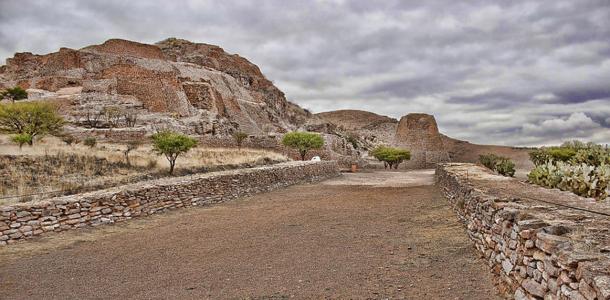
La Quemada is a Mesoamerican site, located in the Villanueva Municipality, in the state of Zacatecas, Mexico. Research suggests it was first occupied around 300 AD, and reached its peak between 600 and 850 AD. It became a leading center that connected 220 settlements via a network of roads to circulate taxes and resources that sustained the population and formed processional routes to honor their deities. La Quemada represents the most significant monumental settlement in north central Mexico for its architecture. At the site there is a large residential area with square columns, a ball game court, and a pyramidal base called a Votive Pyramid.
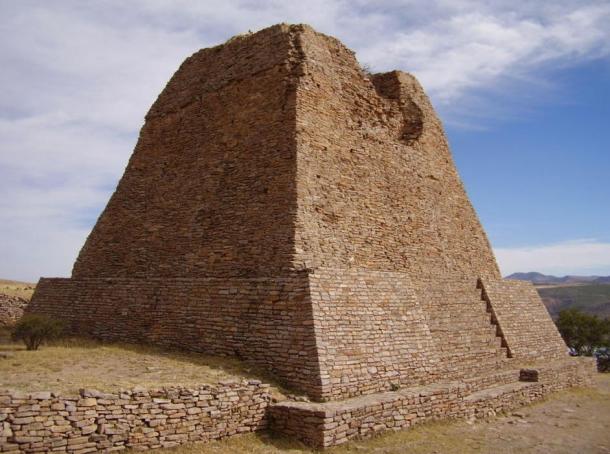
La Quemada is considered somewhat of an enigma among historians and archaeologists. Given the distance between La Quemada and the center of Mesoamerica, its role and cultural background has been subject of many different interpretations. Some have identified it as the place of the legendary Chicomostoc, where the Aztecs were said to have remained for nine years during their voyage to Anahuac, the heartland of Aztec Mexico. Others have associated it with a Caxcan site, a Teotihuacán fortress, a Tarascan centre, a fort against Chichimeca intruders, or a Toltec trading post.
While researchers do not yet have all the answers, a new study published in the journal Proceedings of the National Academy of Sciences has uncovered a new grisly piece of information about this mysterious site – they ate their enemies and hung up their remains for display.
A pair of archaeologists from Arizona State University studied bones found inside and outside the compound, which dated to between 500 and 900 AD. They found that the outdoor bones show signs of cut marks, bone splinters, and burning, all characteristics consistent with cannibalism. In addition, some of the skulls were found with holes drilled in the center, suggesting they belonged to defeated enemies whose heads had been placed on public display outside the temple walls.
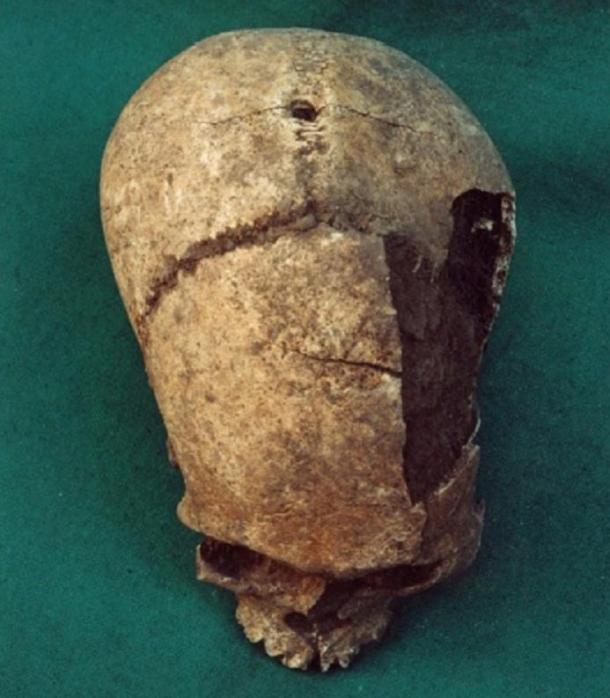
On the other hand, bones found inside the compound show signs of disarticulation and defleshing after some period of post-mortem desiccation and decay. They also represent all ages and both males and females, suggesting the purpose of the defleshing was ancestor veneration.
The researchers believe the indoor bones belonged to the local residents of La Quemada, while the outdoor bones were of ethnic others, who came to attack.
“During the time when the people were living there, the researchers note, the area was under stress, enduring upheaval due to rapid change—Teotihuacan city had collapsed and a new society was under development, one that consisted of multiple smaller scale groups living across the Northern Frontier. That inevitably led to violence, which the researchers note, can be seen in how the bodies of the vanquished were treated,” reports Phys.org. “Other evidence of the violence that occurred was the architecture itself, fortresses meant to keep invaders at bay.”
This Section Under Construction. (Outline)

-there truly is overwhelming archaeological AND historical evidence of destruction, BOTH at 380 AD and 1100 AD. So we’re going to go through every site and show the archeological evidence for BOTH timelines. But first lets go through the evidence of why the timelines might be off.
-we see evidence of TWO great destructions. So TWO possibilities. With two reasons for the second possibility. (bom wrong or c14 wrong)
-Multiple Calendar Confusion: Gordon Brotherston demonstrated that most of the codices from central and southern Mexico had a “base date” from which the many calendar dates within them were calculated. (A Key to the Mesoamerican Reckoning of Time: The Chronology Recorded in Native Texts; British Museum Occasional Papers 38, London, 1982). Brotherston identifies three codex groups, each with a different base date, which he labels Tulteca, Mixtec, and Chichimec. The Tulteca & Mayan base date is the year 13 Reed 3114 BC (strangely similar to the Jewish Calendar base date of 3761 BCE); the Mixtec from Tilantongo, Oaxaca, 13 Reed 11 AD as shown in the Codex Boturini (strangely similar to the Christian and Book of Mormon base date – Tilantongo being our land of Nephi and immigrants to xochicalco); and the Chichimec, 13 Reed 647 AD (strangely similar to the 774 carbon spike and Quetzalcoatl the prophet date). The Codex Vienna has the Tulteca base date, 3114 BC (Codex Nuttall, pp. 73, 76), although in the Mixtec art style, while the Codex Nuttal has the Mixtec base date, AD 11 (Codex Nuttall, p. 4). reference adapted from Bruce W. Warren.
-the Toltec fixation with the Teotihuacan Quetzalcoatl cult. Its shown in Chichenizta, in Xoxicalco which was settled from Tilantongo/Central Oaxaca rulers/traders, Cholula,
-Go through each individual city and battle.
–Teotihuacan. quote of sacrifices
–Chalchihuites. (peak at 400 AD, then decline)
–Sonora Culture (find where a decline hits at 400 AD
–Hopewell Culture (find info)
Be sure to add pics of the bodies, skull racks and cannibalisms headlines, both here and PowerPoint, so if people just scroll through they get the point of it
.
Viking, Norman, Austronesian Connection to the Book of Mormon?
Go through the names of each of the generals mentioned in Mormon & Moroni and the etymology of how many of them are Greek/Latin or Austronesian and then correlate teh dates with the Viking anals, Norman conquest and Eastern US runestones and Maine Penny and L’anse meadows viking site and how we likely have the scope of the viking colonization of America wrong. Show friedbergs painting and make a case for the later timeline being either a repeat or the real date. Show the Tucson artifacts with translation.


